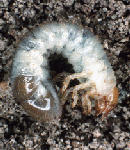 Japanese
Beetles...They're Back!
Japanese
Beetles...They're Back!
 Japanese
Beetles...They're Back!
Japanese
Beetles...They're Back!
It's mid June in Virginia and the Japanese beetles (Popillia japonica)are one again swarming in search of our tasty garden foliage. A good friend of mine once told me, "When we get to the Pearly Gates, Saint Pete's gonna' say, "You guys were not meant to stumble up on that thing you call an internal combustion engine, and I afraid you'll all have to spend a little time downstairs for that little discovery." Sure enough, the japanese beetle was accidentally introduced into the United States in 1916.
Another friend of mine tells of the Department of Agriculture doing what it could to stop the spread of the beetles south from the Northeastern states in the early 1940's. Trucks hauling bulk produce south on U.S. Route 1 were stopped and their produce was loaded into a giant screened container with a hand crank. As the container was turned, much like a ferris wheel, any produce yielding a Japanese beetle through the wire was destroyed. Further down on U.S. Route 2, my friend worked at a checkpoint which stopped all southbound cars, opened their trunks, and inspected for potted plants. The dirt was knocked from the roots to check for beetle grubs. If none were found, the inspector re-potted the plant and sent you on your way. I bet there were a lot of dead houseplants before they made it 40 miles south to Richmond.
Japanese beetles "skeletonize" the foliage of plants, leaving veins only. They are not picky, but they do seem to favor plants with a red tinge in the leaves or stems. The favorites list includes roses, cherries, plums, crape myrtles, Japanese red maples, hardy hibiscus, grapes, crabapples, etc. as well as many vegetables. The beetle emerges from the soil in mid June as an adult beetle and feeds on plant foliage. They also breed and lay their eggs back into the turf, where the beetle grub will develop over the next year.
The fall grub is in place by mid August feeding on grass roots and living close to the surface of the soil. This is the easiest stage of control in the grubs life cycle as they are young, tender, and easily accessed. As the soil temperature drops, the grub moves deeper into the soil and eventually stops feeding. This partially matured grub will go as deep as 6 inches into the soil for winter protection.
In the spring the grub begins to move back towards the surface of the soil as the ground warms. By mid April they should be near the surface and feeding heavily on the roots of the turf. In the spring, they are approaching full maturity which makes them hardier and less likely to respond to many forms of chemical grub control.
The best long-term control for Japanese beetle grubs is Milky Spore which is a natural bacterial spore specific to the Japanese beetle grub. The spore infects the grubs and multiplies in their body as it kills them. When the grub dies the body releases higher numbers of spore. Over time the spore becomes very concentrated in the soil and will be effective for years to come. The spore generally takes 1 to 3 years to establish. The finer the soil particle, such as heavy clay, the longer the establishment time.
Two forms of chemical control are from Bayer Advanced Products. One is Bayer Advanced 24 Hour Grub Control, which contains Dylox. This products requires correct timing. Apply in early April or mid August. The compound is not long lasting, but it will wipe out your entire grub population in short order.
The second product is Bayer Advanced Season Long Grub Control which contains the compound known as Merit. This product should be applied in early May for maximum efficiency of your dollar. While the product is strongest at the point of application, it is also absorbs systemically by the grass roots, rendering a killing power through August so that you have controlled the spring and fall generations of the Japanese beetle grub in one season.
For immediate relief of the beetles be prepared to spray them contact insecticides such as Sevin (chemical) or Pyrethrin/Rotenone (natural) every 4 to 7 days as needed for about 3 weeks. Systemic insecticides such as Orthene or Merit are too slow in their systemic action. For next year, natural Neem oil extract (Green Light Rose Defense) will help if applied weekly for 3 or 4 applications prior to the emergence of the adult beetle. Neem has little effect unless applied in this preventative manner.
Beetle Traps are quite popular and give the gardener great satisfaction, in that you get to see the little suckers in a bag. Unfortunately, the traps attract the beetles with floral and pheromone lures. While they are standing in line to get into the trap they can do a lot of damage. The worst thing you can do is place a trap in the center of the flower bed, hang it off of the branch of your cherry tree, or place one at all four corners of your property. No matter which way the wind blows, the lure will drift through your plants, drawing the pest to your leaves and blossoms. The prevailing winds come from the west, so place the traps 30 feet away from your plants on the eastern side of the property. Better yet, buy a trap and give it to your neighbor. Until next week.
Andy Lynn